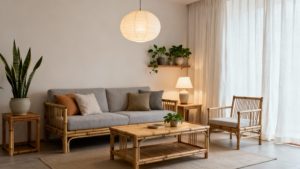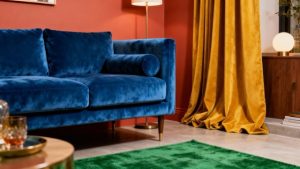Introduction
Flat, two-dimensional interiors are having a moment of silence—and it’s a good thing. In 2025, texture is the hero ingredient that transforms ordinary rooms into extraordinary spaces.
Texture engages our senses in ways smooth surfaces simply cannot. It invites touch, creates visual interest, and adds depth and character to any room. Whether it’s the warmth of a velvet curtain against your hand, the subtle grain of a textured wallpaper catching light, or the inviting pile of a layered rug underfoot—texture makes spaces memorable and livable.
This comprehensive guide will show you how to layer textures throughout your home to create rooms that are visually rich, tactilely pleasing, and utterly sophisticated.
Why Texture Matters
Visual Impact:
Adds dimension to flat walls and surfaces
Creates interest without clutter
Plays with light differently than smooth materials
Makes spaces feel more intentional and curated
Sensory Experience:
Invites touch and engagement
Creates emotional warmth
Feels more “lived-in” and welcoming
Engages multiple senses simultaneously
Design Sophistication:
Shows attention to detail
Indicates quality and intentionality
Works in any style (modern, traditional, eclectic)
Elevates perceived value
Acoustic Benefits:
Textured surfaces absorb sound
Reduces echoing in empty spaces
Creates more intimate, cozy environments
Textured Wall Treatments
Beyond Paint: Exciting Wall Options
1. Textured Wallpaper
Embossed patterns add dimension
Geometric designs create visual interest
Natural fiber wallpapers (grasscloth, linen)
Subtle or bold—choose your statement
How to use: Feature walls, accent panels, or full-room application depending on pattern intensity
2. Shiplap & Wainscoting
Horizontal or vertical wooden slats
Creates depth through shadow lines
Works beautifully in any color
Timeless, classic appeal
3. Plaster & Venetian Finishes
Smooth plaster with layered application
Creates soft, undulating surface
High-end, sophisticated look
Catches light beautifully
4. Exposed Brick
Natural texture and warmth
Works in modern, industrial, rustic spaces
Ages beautifully
Authentic character
5. Stone or Tile Accents
Stacked stone feature walls
Textured tile applications
Creates dramatic focal points
Durable and practical
6. Textured Paint Finishes
Sand or popcorn texture
Matte vs. glossy (matte adds texture through light absorption)
Metallic finishes catch light
Budget-friendly texture option
Ceiling Texture: The Often-Forgotten Fifth Wall
Don’t neglect your ceiling! It’s an opportunity for dramatic impact.
Textured Ceiling Options:
Coffered Ceilings
Geometric boxes create dramatic shadows
Traditional elegance
Architectural interest
Works in formal and modern spaces
Exposed Beams
Natural wood or faux beams
Creates rustic or contemporary feel depending on style
Adds visual height and interest
Draws eyes upward
Textured Ceiling Treatments
Stucco finish
Popcorn texture (though less trendy)
Acoustic tiles with visual interest
Patterned wallpaper on ceiling
Painted Ceilings
Deep colors add coziness (dark walls recede, making ceiling feel lower—use for high ceilings)
Matte finish shows texture better than glossy
Creates intimate spaces
Curtains & Drapes: Fabric Texture as Statement
Curtains aren’t just functional—they’re textile art.
High-Texture Fabric Options:
Velvet
Luxurious pile creates rich texture
Dramatic light-catching qualities
Available in jewel tones and neutrals
Perfect for statement curtains
TradeFurnish Blackout Velvet Thermal Curtains showcase this beautifully
Jacquard
Woven patterns create dimension
Sophisticated geometric or floral designs
Structured, formal appearance
Quality feel
TradeFurnish Jacquard Geometric Curtains offer this option
Linen
Natural, visible weave
Subtle texture that catches light
Casual elegance
Improves with age
Perfect for Japandi or minimalist spaces
Textured Blends
Silk-cotton combinations
Linen-rayon blends
Multiple textures in single fabric
Dynamic visual interest
Lace & Sheer Overlays
Delicate texture for privacy without opacity
Layers reveal pattern as light changes
Romantic or modern depending on pattern
Works beautifully layered with solid curtains
How to Use Curtain Texture:
Statement wall with textured curtains (let them be the hero)
Floor-to-ceiling for drama
Pair with smooth walls for balance
Use textured hardware to amplify effect
Layering Rugs: Textural Foundation
Rugs are where floor texture truly shines.
Rug Texture Combinations:
Layering Method:
Base rug – Larger, higher texture (wool, jute)
Mid-layer – Medium texture rug
Top layer – Smaller accent rug with contrasting texture
Popular Texture Pairs:
Jute + wool + flat-weave cotton
Shag + geometric woven + leather-trimmed
Natural fiber + modern textured pattern + solid accent
Textured Rug Materials:
Jute – Coarse, natural, earthy
Wool – Soft pile, ages beautifully
Sisal – Durable, subtle texture
Cotton Dhurrie – Woven flat-weave with pattern
Shag – Deep pile, luxurious underfoot
Braided – Artisanal, handmade quality
Texture Tip: Mix organic (jute, wool) with structured (geometric pattern) for balance.
Cushions & Throws: Tactile Layers
These textile accessories are texture powerhouses.
Cushion Texture Combinations:
Mix These Textures:
Velvet (luxe)
Linen (organic)
Knit or cable (cozy)
Faux fur (drama)
Embroidered (detail)
Arrangement Principle:
Odd numbers (3, 5, 7) of cushions
Mix textures and colors
Vary sizes
Include patterns and solids
Cushions should look casually placed, not rigid
Throw Texture Options:
Chunky knit (modern, cozy)
Faux fur (glamorous)
Woven wool (sophisticated)
Linen blend (relaxed elegance)
Sherpa (plush comfort)
Styling: Drape throws over sofas, armchairs, and bed ends for tactile warmth and visual interest.
Upholstery & Furniture Texture
The furniture itself can showcase texture.
Upholstery Choices:
Velvet
Rich, luxurious appearance
Catches light dramatically
Available in jewel and neutral tones
Statement piece material
Linen
Casual, lived-in texture
Shows wear beautifully
Comfortable and breathable
Works in any design style
Chenille
Soft, textured yarn
Warm and inviting
Hides wear well
Durable for high-traffic furniture
Leather (Real or Faux)
Natural texture and patina
Improves with age
Versatile with any style
Tactile and substantial
Woven or Patterned Fabric
Built-in texture through pattern
Hides stains well
Sophisticated appearance
Adds visual interest
Quilted or Tufted Upholstery
Creates dimensional surface
Adds detail and character
Works beautifully in modern and traditional spaces
Additional Texture Elements
Wood Finishes:
Raw wood shows grain beautifully
Weathered finishes add age and character
Polished vs. matte creates different texture feels
Metal Accents:
Brushed vs. polished
Textured hardware
Metal wall art
Creates contrast with soft materials
Artwork & Wall Decor:
Textured canvas paintings
Woven wall hangings
3D wall sculptures
Wooden wall art
Window Treatments:
Wooden blinds (texture through horizontal lines)
Textured shades
Structured hardware
Layered treatments
Room-by-Room Texture Inspiration
Textured Living Room:
Textured wallpaper accent wall
Velvet curtains
Layered rugs (jute + wool)
Mix of cushion textures
Woven throws
Textured ceiling or exposed beams
Textured Bedroom:
Quilted headboard
Linen bedding with visible weave
Sheer overlay curtains with solid textured drapes
Multiple pillow textures
Woven rug
Textured throw blanket
Textured Dining Space:
Plaster or textured wallpaper
Textured light fixture
Natural wood table with visible grain
Upholstered chairs with mixed textures
Textured runner rug
Woven wall hanging
Layering Texture: The Formula
Success Formula for Textured Rooms:
Start with one textured wall or feature
Wallpaper, exposed brick, or shiplap
Anchor the room
Layer in soft textures
Velvet or linen curtains
Cushions and throws
Creates comfort
Add structural textures
Rugs with weave or pile
Wooden furniture with grain
Provides grounding
Include fine details
Embroidered cushions
Textured hardware
Woven wall hanging
Elevates sophistication
Maintain balance
Don’t overwhelm with all textures
Include smooth surfaces (painted wall, simple furniture)
Mix matte and glossy finishes
Color Considerations with Texture
How Texture Affects Color:
Dark textured surfaces appear deeper
Light textured surfaces appear airier
Matte textures look softer
Glossy textures look sleeker
Pile direction changes color perception
Pro Tip: In small spaces, choose lighter colored textures for visual expansion. In large spaces, darker textured materials add coziness.
Common Texture Mistakes to Avoid
Too many competing textures
Creates visual chaos
Solution: Stick to 3-4 primary textures
All textures in one color
Looks monochromatic, not sophisticated
Solution: Vary texture with slight color variation
Ignoring scale
Small textures in large rooms disappear
Large textures in small spaces overwhelm
Solution: Match texture scale to room size
Forgetting smooth surfaces
All texture is visually exhausting
Solution: Balance with smooth, calm areas
Poor quality textured materials
Shows wear quickly
Loses appeal fast
Solution: Invest in quality
Not considering maintenance
Textured surfaces collect dust
Solution: Choose textures you can realistically clean
TradeFurnish Products for Texture
Our collections celebrate texture:
Velvet Embellished Cushion Covers – Luxury texture
Blackout Velvet Thermal Curtains – Rich pile and drama
Jacquard Geometric Curtains – Woven dimension
Linen Blend Textured Curtains – Organic, subtle texture
Layered Rugs – Multiple texture options
Turkish Cotton Towels – Plush, inviting texture
Quilted Bedspreads – Dimensional comfort
Conclusion: Texture Transforms Spaces
Texture is the secret ingredient that separates cookie-cutter homes from personal sanctuaries. It’s what makes a room memorable, comfortable, and utterly yours.
Start by adding one textured element—a velvet cushion, a textured curtain, a patterned rug. Feel how it changes the room. Layer from there.
Your home will thank you for the depth, richness, and character that texture brings.
Because at TradeFurnish, we believe that how a room feels is just as important as how it looks.



